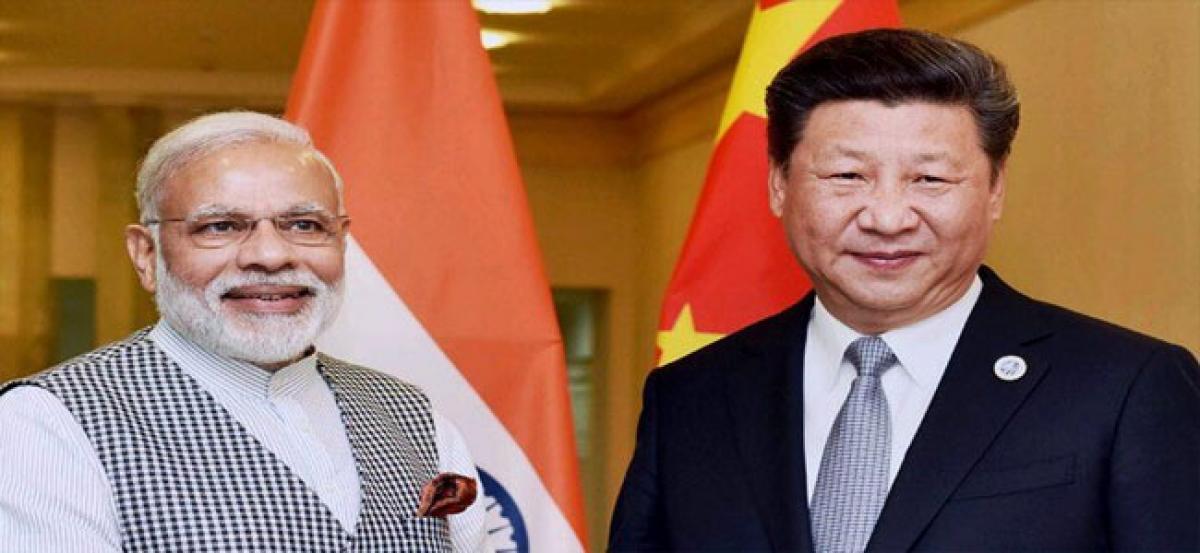Live
- A nomination was filed on the second day for the Nagar Kurnool parliamentary seat
- SP Gaikwad inspected the Telangana Amarnath Saleswaram Jatara yatra arrangements
- Rahul Gandhi's decision to contest from Wayanad shows 'lack of confidence': BJP President Nadda
- IPL 2024: Delhi bowlers will go after all of SRH’s top-order batters, says head coach Ricky Ponting
- At Amroha rally, PM Modi sends out ‘meaningful’ message for Muslims and Hindus
- Tripura records highest 79.83 pc voter turnout in Northeast
- The government has to clear the confusion
- UP: Police officers, govt doctors to appear virtually in courts
- White tigress Sneha dies at Nandankanan zoo
- World Liver Day 2024: Follow these easy lifestyle tips to cleanse and maintain a healthy liver
Just In

The BRICS meeting in Xiamen in China last week was a timely opportunity for both India and China to end the high-altitude and potentially high-voltage stand-off at the Doklam plateau. Many political observers around the globe feared a spark, ignition and even a war. Concurrent \"cross-continent\" threats by North Korea aimed at the US brought the situation to the brink.
Moving away from "assaulting with stones" to "building with BRICS" could be the new mantra for India and China
The BRICS meeting in Xiamen in China last week was a timely opportunity for both India and China to end the high-altitude and potentially high-voltage stand-off at the Doklam plateau. Many political observers around the globe feared a spark, ignition and even a war. Concurrent "cross-continent" threats by North Korea aimed at the US brought the situation to the brink.
BRICS diplomacy, including its extremely well thought-out and carefully drafted declaration of 71 articles showed not only the mature intentions of five countries – Brazil, Russia, India, China and South Africa – in the messy world, but the skillful subtlety of India and China in avoiding a flash war in the Himalayas.
Fortunately, there is a game-changing and long-term win-win opportunity for both India and China whose time has come. Though the BRICS declaration is multilateral, India and China can take away the potentially strong bilateral messages on collaborative approaches on a number of issues that would make both countries lead global development.
Such opportunity should not be allowed to be overshadowed by relatively trifling issues like territorial conflicts, trade wars, NSG admission and international naming of terrorists and, above all, by media hype. Yes, border-protection is important, but more crucial is the protection of the people's future that they want in both the countries.
Having disengaged from the Doklam plateau, China and India should now engage in availing themselves the huge opportunity of constructive and positive collaboration on Sustainable Development and Climate Change. There are three key reasons that offer higher takeoff points for Xi and Modi to engage in a strategy that benefits people of both the countries.
First, both of them have shown similar approaches to address the common challenges facing them on international platforms. Unprecedented air pollution, life-threatening climate change, resource-draining energy dependence, restless youth, serious unemployment, fast-urbanising population, the eroding agricultural base and terrorism are the common challenges that the two largest- and fastest-growing countries have to face squarely.
Second, the personal chemistry between Modi and Xi is perceived to be conducive for longer-term cooperation. Even when the Indian and Chinese battalions were facing each other on the Doklam plateau, Modi and Xi were facing each other in Hamburg on the margins of G-20 summit to discuss preparations for Xiamen. Both showered praise on each other's national efforts in economic and social development and resolved to address the issue of terrorism.
Third, both countries have already collaborated smartly to institutionalise efforts on critical issues like clean energy, sustainable development,
infrastructure and finance. Apart from their skilled strategies to leverage the BRICS platform – which is neither regional nor economic and represents 40 per cent of world population and 25 per cent of world's GDP – there are two more excellent enabling initiatives of China, fully supported by India as major shareholder, i.e., the Asian Infrastructure Investment Bank (AIIB) based in Beijing and New Development Bank (NDB) based in Shanghai, with a capital of $100 billion each.
With these three enabling ecosystems, India and China can take global positioning though strategic collaboration. Collaborative innovations – which the Xiamen Declaration refers to 12 times – in reducing carbon emissions through clean energy and implementing the Paris Climate Agreement and SDGs,
to which both countries are passionately attached, could prove to be the most rewarding strategy for both. US President Donald Trump's decision to pull out of the Paris Agreement will prove to be the pushing-in prospect for India and China by being technology leaders in clean energy and sustainable development – to which the Xiamen Declaration refers to 23 times.
Indeed, China and India account for 60 per cent of incremental world energy demand at present. Coal-dominated and oil-dependent energy structures are the drivers of energy insecurity. Use of fossil fuels and inefficient use of bio-mass burning are responsible for air pollution that causes premature deaths of 5.5 million people in the two countries together (China's share being 4.3 million), as per the World Health Organisation.
Strategic collaboration would lead to a healthy and pollution-free life for their people. Moving away from "assaulting with stones" to "building with BRICS" could be the new mantra for India and China. The timing favours those who dare to act despite challenges and differences. The BRICS meeting in Xiamen is that time.
By Rajendra Shende

© 2024 Hyderabad Media House Limited/The Hans India. All rights reserved. Powered by hocalwire.com







